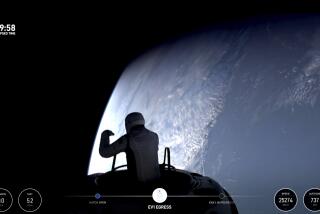Fall 24 miles to Earth with Felix Baumgartner in new space-jump video
- Share via
What’s it like to fall to Earth from 24 miles up in the stratosphere? Only Felix Baumgartner knows for sure -- but a new video takes you along for his record-breaking ride.
On Oct. 14, 2012, the Austrian skydiver stepped off the narrow porch of an experimental capsule hovering 127,852 feet over New Mexico and became the first free-falling person to break the sound barrier. Instruments recorded his top speed at 843.6 miles per hour, which is 1.25 times faster the speed of sound.
The stunt was pulled off with the help of Sage Cheshire Inc. and other Southern California aerospace companies. As my colleague W.J. Hennigan reported, these firms are anticipating commercial space travel and want to know whether passengers can safely bail out from stratospheric heights. Energy drink maker Red Bull funded the mission, to the tune of millions of dollars.
Seven GoPro HERO2 cameras recorded the jump. The first six seconds are featured in a commercial set to air during Super Bowl XLVIII. A much longer -- and more harrowing -- view of the jump can be seen in the video above.
It begins with Baumgartner speaking to Joe Kittinger, the previous free-fall record-holder who jumped from 102,800 feet in 1960. Kittinger, a former Air Force test pilot, was Baumgartner’s link to the mission control room.
Kittinger: “All right, stand up on the exterior step, keep your head down, and our guardian angel will take care of you.”
Baumgartner: “OK, I’m doing it now.”
Kittinger: “Release the helmet tie-down strap.”
Baumgartner tugs at the white strap. His legs look unsteady as he holds himself in place on the narrow step. A report released last year by a team of NASA astronauts, Air Force officers and aerospace experts said Baumgartner’s heart was beating at a rate of 176 beats per minute. (A healthy adult has a heart rate of 60 to 100 beats per minute.) His breathing sounds labored as he speaks.
Baumgartner: “I wish you could see what I could see. Sometimes you have to be really high up to understand how small you are. I’m coming home now.”
He salutes and descends toward Earth.
At first, everything is serene. But in that first minute, he begins to spin -- a dangerous development that can leave a skydiver unconscious.
Baumgartner makes two utterances of uncertain meaning.
Kittinger: “Can anyone understand him?”
There is no response for several seconds. Then the jumper becomes coherent.
Baumgartner: “I have been in a violent spin for a long time. Feels like I have to pass out.”
In a few more seconds he has stabilized. Cheers can be heard from the control room.
Baumgartner broke through the sound barrier during the spin, about 30 seconds into his fall. (He later said he had no idea when he crossed that historic threshold: “I didn’t feel it at all.”)
As Baumgartner descends, the horizon of Earth goes from curved to flat and the sky brightens to its familiar shade of blue.
Just past the four-minute mark, he pulls the ripcord on his parachute. It deploys about 8,000 feet above the desert floor, imparting a force that was measured at 3.27 times the force of gravity.
Baumgartner: “That was really tough.”
The jump was live-streamed on YouTube and watched by more than 8 million people.
If you can’t wait for your chance to travel to the edge of space, follow me on Twitter and “like” Los Angeles Times Science & Health on Facebook for more stories like this.







